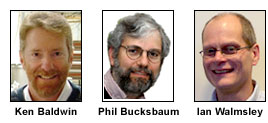TUCSON, Ariz., Oct. 19 -- Rod Alferness, senior vice president of optical networking research at Bell Laboratories, was elected 2006 vice president of the Optical Society of America (OSA), and Ken Baldwin, Philip Bucksbaum and Ian Walmsley were elected as new directors at large, during the association's annual meeting this week in Tucson.
 As vice president, Alferness also makes a four-year commitment to OSA’s board; he will automatically become president-elect in 2007, president in 2008 and past president in 2009. The new directors at large, who will replace three outgoing board members, will serve for three years. All will be formally inducted on Jan. 2.
As vice president, Alferness also makes a four-year commitment to OSA’s board; he will automatically become president-elect in 2007, president in 2008 and past president in 2009. The new directors at large, who will replace three outgoing board members, will serve for three years. All will be formally inducted on Jan. 2.
 Alferness was formerly CTO and vice president of advanced technology and architecture for the optical networking group at Lucent Technologies and was previously head of the photonics networks research department of Lucent Bell Laboratories in Holmdel, N.J. His early research at Bell Labs included the demonstration of novel waveguide electro-optic devices and circuits and their applications in high-capacity lightwave transmission and switching systems, which led to the development of titanium-diffused lithium niobate waveguide modulators that are now used as the high-speed signal-encoding engine in fiber optic transmission systems. He also made contributions in photonic integrated circuits in InP, including widely tunable lasers, and in photonic switching systems and reconfigurable wavelength-division-multiplexed optical networks. In the mid-1990s, he was an originator and the Bell Labs program manager for the DARPA-funded MONET project, which demonstrated the feasibility of wavelength-routed optical networks now being implemented for both backbone and metro networks.
Alferness was formerly CTO and vice president of advanced technology and architecture for the optical networking group at Lucent Technologies and was previously head of the photonics networks research department of Lucent Bell Laboratories in Holmdel, N.J. His early research at Bell Labs included the demonstration of novel waveguide electro-optic devices and circuits and their applications in high-capacity lightwave transmission and switching systems, which led to the development of titanium-diffused lithium niobate waveguide modulators that are now used as the high-speed signal-encoding engine in fiber optic transmission systems. He also made contributions in photonic integrated circuits in InP, including widely tunable lasers, and in photonic switching systems and reconfigurable wavelength-division-multiplexed optical networks. In the mid-1990s, he was an originator and the Bell Labs program manager for the DARPA-funded MONET project, which demonstrated the feasibility of wavelength-routed optical networks now being implemented for both backbone and metro networks.
Alferness was an elected member of the OSA board from 2001 through 2003 and has chaired numerous OSA committees.
Ken Baldwin is a senior fellow in the Institute of Advanced Studies at the Australian National University in Canberra and deputy director of the Australian Research Council Centre of Excellence for Quantum-Atom Optics. His research interests are in cold-atom physics and Bose-Einstein condensation and in high-resolution laser spectroscopy of atoms and diatomic molecules, especially in the vacuum ultraviolet. He is a fellow of OSA and of the Australian Institute of Physics.
Philip Bucksbaum is an atomic physicist whose main research interests are fundamental light-matter interactions, particularly the control of quantum systems using ultrafast laser fields. He has developed new sources of ultrafast radiation in the infrared, visible, ultraviolet and x-ray spectral regions. He is a professor of physics at the University of Michigan and is director of the FOCUS Center, a National Science Foundation-funded Physics Frontier Center devoted to the frontier of coherent control in ultrafast science.
Ian Walmsley is a professor of experimental physics at the University of Oxford, England, where he is also head of the subdepartment of atomic and laser physics. He was formerly on the faculty of the Institute of Optics at the University of Rochester and was its director from 2000 to 2001. His research has involved quantum phenomena on ultrafast timescales, including the generation of nonclassical radiation and its characterization, manipulation of matter using closed-loop methods and the development of methods for the measurement of ultrafast optical waveforms.
For more information, visit: www.osa.org